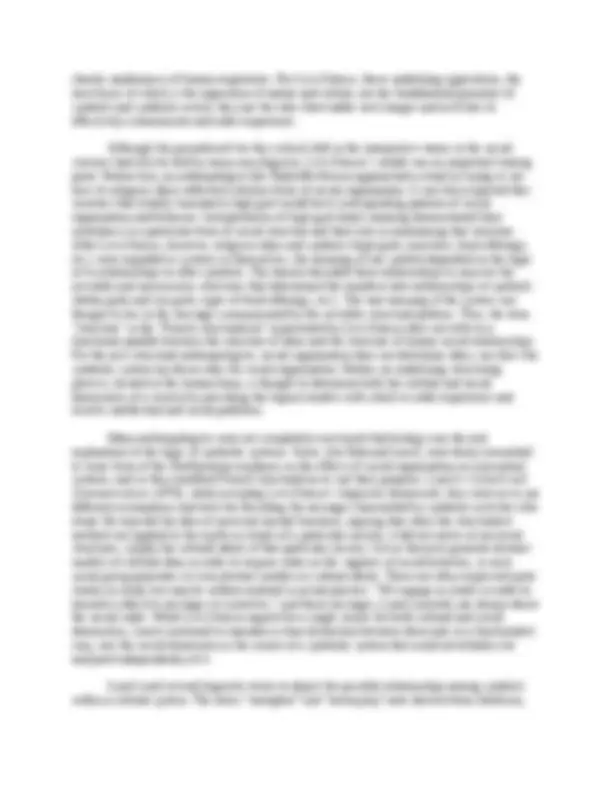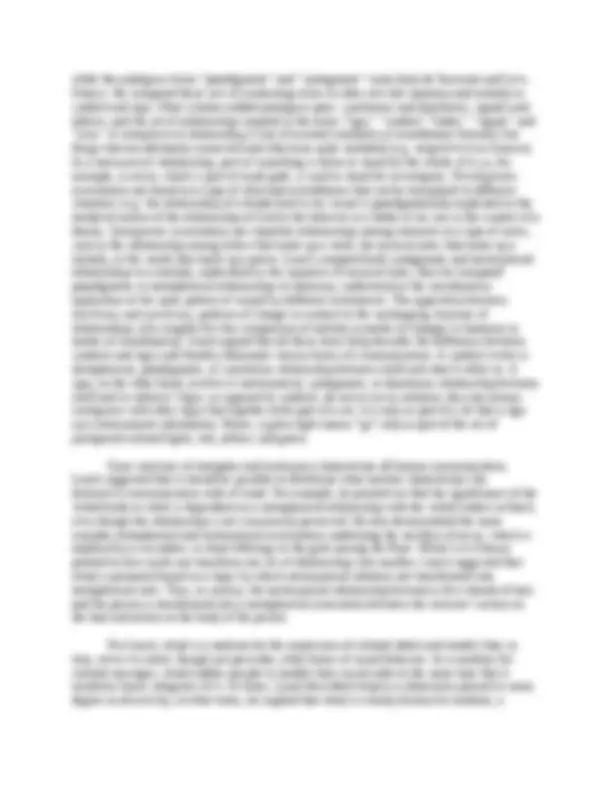





Study with the several resources on Docsity

Earn points by helping other students or get them with a premium plan


Prepare for your exams
Study with the several resources on Docsity

Earn points to download
Earn points by helping other students or get them with a premium plan
Community
Ask the community for help and clear up your study doubts
Discover the best universities in your country according to Docsity users
Free resources
Download our free guides on studying techniques, anxiety management strategies, and thesis advice from Docsity tutors
The contrasting perspectives of functionalists and culturalists on the relationship between symbols, cultural systems, and social organization. Culturalists argue that symbols and symbolic action are more autonomous and language-like, focusing on their communicative function within the system. They propose that culture illuminates primary levels of meanings, values, and attitudes that shape social organization. Levi-strauss's structural anthropology is discussed as a powerful method for analyzing cultural systems of symbols, which are seen as having sufficient autonomy to be analyzed independently of social structure. The document also discusses the influence of linguistic models on the analysis of cultural phenomena and the relationship between symbols and signs.
Typology: Study notes
1 / 5

This page cannot be seen from the preview
Don't miss anything!




S/A 4074: Ritual and Ceremony Lecture 14: Culture, Symbolic Systems, and Action 1 Theorists who began to go beyond the framework of functional structuralism have been called symbolists, culturalists, or, more awkwardly, symbolic-culturists. In contrast to how functionalism closely links symbols to social organization, culturalists tend to see these links as weak and indirect, emphasizing instead the autonomy and language-like nature of a cultural system of symbols. Hence, culturalists interpret the symbols and symbolic action so important to ritual less in terms of their connections to the structures of social organization and more in terms of an independent system organized like a language for the primary purpose of communication. This shifts interpretation from a focus on what social reality may be represented (and maintained) by a symbol to a focus on what the symbol means (communicates) within the context of the whole system of symbols in which it is embedded. This new focus, it is argued, illuminates something other than the social organization of human groups; it illuminates “culture” as a more primary level of meanings, values and attitudes that effectively acts to shape social organization. In this view, culture cannot be simply reduced to being the mere projection of social organization, and social organization is, theoretically, not primary but secondary. Defined as a primary system, culture has been declared to have sufficient autonomy to be analyzed independently of social structure, although it is generally recognized that in actual fact cultural systems interact constantly with social organization in complex ways. Social and cultural systems clearly comprise a holism, and a fresh variety of methods have been proposed to analyze it without reducing the cultural to the social or the social to the cultural. Indeed, many cultural theories of ritual implicitly or explicitly describe ritual as the means by which the cultural system and the social system are able to interact and harmonize with each other. The emergence of a perspective more concerned with questions of meaning than with questions of function, with so-called cultural phenomena than with so-called social phenomena, was not a sudden one. Indeed, the difference in viewpoint is not simply a historical progression from on theory to another, since a British emphasis on social issues coexists with an American emphasis on culture. Nor can a clear line be drawn between functional-structuralists, on one hand, and symbolic-culturalists on the other. Many theories incorporate aspects of both perspectives, and a number of theorists have emphasized one or the other at different stages of their careers. Some even attempt to synthesize the two within a single mode of analysis. Victor Turner, Mary Douglas, and Edmund Leach, for example, can be fitted into both groups. Thus, the classification of theories we discuss in this section reflect a rather provisional scholarly consensus as to the dominant emphasis of any theory or scholarly output. Analogies with language had turned up in earlier theories of ritual, notably those of Radcliffe-Brown and Eliade. Both noted the structural similarities between ritual and language when approached in terms of morphology (the study of form and structure). They suggested that linguistic morphemes (the smallest meaningful word units) were analogous to the smallest meaningful structural units of ritual, which they envisioned as either set routines of action (e.g. purification acts or offerings) or set units of symbolism (e.g. sun-fire-light symbols or water- birth-life symbols). Other scholars compared rites to texts, arguing that both needed to be
“decoded” to determine their real meaning, which was one other than the conscious intentions and interpretations given to those activities by the actors themselves. While some of this terminology has evoked psychoanalytic notions of an unconscious subtext, it also resonated with the emergence of a science of linguistics that focused on the unconscious processes and patterns underlying the spoken statement. Symbolic Systems and Symbolic Action: The analytic power of the cultural approach derived from its distinction between: (1) a cultural level frequently equated with the conscious and unconscious ideals and values of a group; and (2) a social level frequently equated with the empirical realities of lived existence. This two-tiered model made it possible to analyze culture as a semi-autonomous system, even though it provoked pressing questions about how such an autonomous cultural system related to the actual social conditions of a community. When Levi-Strauss introduced a particularly powerful method for analyzing cultural systems of symbols, many were simultaneously receptive to it and wary of the problems it raised. Levi-Strauss’s method of structural anthropology used a linguistic model to explain cultural phenomena other than language. Language, he wrote, is “the cultural phenomenon par excellence...the most perfect of all those cultural manifestations which, in one respect or another, constitute systems, and if we want to understand art, religion or law, and perhaps even cooking or the rules of politeness, we must imagine them as being codes formed by articulated signs, following the pattern of linguistic communication.” His method drew on developments in structural linguistics pioneered by Roman Jakobson and Ferdinand de Saussure that revolutionized linguistics in several ways. Their work effectively shifted linguistics from study of conscious spoken speech to study of the unconscious infrastructure governing the production of speech. As well, they focused attention on the relationships among terms and how terms formed a linguistic system, as opposed to an earlier focus on how each linguistic term, as an independent entity, related to some real object in the world. From this perspective, de Saussure and Jakobson were able to formulate what they saw as general and universal laws of language. Levi-Strauss did not consider language to be the origin of culture, nor did he regard cultural systems such as art or ritual to be anything more than “akin” to language. Yet, he echoed a conviction held by many linguists when he suggested that the grammar-like rules that governed the production of cultural systems like art or myth or ritual exist neither in culture nor in social organization but in the biological organization of the human brain. Levi-Strauss attempted to uncover this underlying grammar by decoding two main types of cultural phenomena: kinship systems and myth systems. In both, his structural method attempted to go beyond the obvious meaning of kinship rules or mythic story plots to get at the unconscious grammar that regulates the structure of these kinship relations and story plots. In other words, he suggested that below the level of manifest content of kinship patterns and myths, there is another level of meaning and message residing in the grammatical form or coded structure of the system. Human beings impose a meaningful pattern on raw experience, he argued, by classifying things in ways that are not so much logical as analogical, that is, based on common similarities and opposing differences. The resulting system of classes and binary oppositions acts as a framework with which to interpret and order what would otherwise be the
while the analogous terms “paradigmatic” and “syntagmatic” came from de Saussure and Levi- Strauss. He compared these sets of contrasting terms to other sets like harmony and melody or symbol and sign. Other scholars added analogous pairs: synchronic and diachronic, signals and indices, and the set of relationships implied in the terms “sign,” “symbol,”“Index,” “signal,” and “icon.” A metaphorical relationship is one of asserted similarity or resemblance between two things that are arbitrarily connected and otherwise quite unrelated (e.g. serpent=evil in Genesis). In a metonymical relationship, part of something is taken to stand for the whole of it, as, for example, a crown, which is part of royal garb, is used to stand for sovereignty. Paradigmatic associations are based on a type of structural resemblance that can be transposed to different situations (e.g. the relationship of a feudal lord to his vassal is paradigmatically replicated in the medieval notion of the relationship of God to the believer or a father to his son in the context of a family. Syntagmatic associations are chainlike relationships among elements in a type of series, such as the relationship among letters that make up a word, the musical notes that make up a melody, or the words that make up a poem. Leach compared both syntagmatic and metonymical relationships to a melody, understood as the sequence of musical tones; then he compared paradigmatic or metaphorical relationships to harmony, understood as the simultaneous replication of the same pattern of sounds by different instruments. The opposition between diachrony and synchrony , patterns of change in contrast to the unchanging structure of relationships, also roughly fits this comparison of melody (a matter of change) to harmony (a matter of simultaneity). Leach argued that all these terms help describe the difference between symbols and signs and thereby illuminate various forms of communication. A symbol evokes a metaphorical, paradigmatic, or synchronic relationship between itself and what it refers to. A sign, on the other hand, involves a metonymical, syntagmatic, or diachronic relationship between itself and its referent. Signs, as opposed to symbols, do not occur in isolation; they are always contiguous with other signs that together form part of a set; it is only as part of a set that a sign can communicate information. Hence, a green light means “go” only as part of the set of juxtaposed colored lights, red, yellow, and green. Since mixtures of metaphor and metonymy characterize all human communication, Leach suggested that it should be possible to determine what mixture characterizes the distinctive communication style of ritual. For example, he pointed out that the significance of the veiled bride in white is dependent on a metaphorical relationship with the veiled widow in black, even though the relationship is not consciously perceived. He also demonstrated the more complex metaphorical and metonymical associations underlying the sacrifice of an ox, which is replaced by a cucumber, in ritual offerings to the gods among the Nuer. While Levi-Strauss pointed to how myth can transform one set of relationships into another, Leach suggested that ritual is primarily based on a logic by which metonymical relations are transformed into metaphorical ones. Thus, in sorcery, the metonymical relationship between a few strands of hair and the person is transformed into a metaphorical association between the sorcerer’s action on the hair and action on the body of the person. For Leach, ritual is a medium for the expression of cultural ideals and models that, in turn, serves to orient, though not prescribe, other forms of social behavior. As a medium for cultural messages, ritual enables people to modify their social order at the same time that it reinforces basic categories of it. At times, Leach described ritual as a dimension present to some degree in all activity; at other times, he implied that ritual is a fairly distinctive medium, a
language geared for intellectual operations of a particularly abstract and metaphysical kind. Most specifically, he pioneered the idea of ritual as an intellectual operation in which the categories affirmed as the cultural order can be transgressed. Ritual can turn a young boy or girl into a recognized adult, a piece of stolen hair into the means to make someone ill, or bread and wine into the sacralizing presence of a transcendent god. In doing these things, ritual posits bounded categories - child/adult, action here/effect there, human/divine - and then formally transgresses them. The messages that are communicated by ritual use such systems of bounded and transcended categories to promote the continuity and the flexibility of the social order. In other words, for Leach, ritual keeps a system of cultural categories responsive to human needs: ritual keeps culture meaningful. In the next class, we turn to the related work of Clifford Geertz.